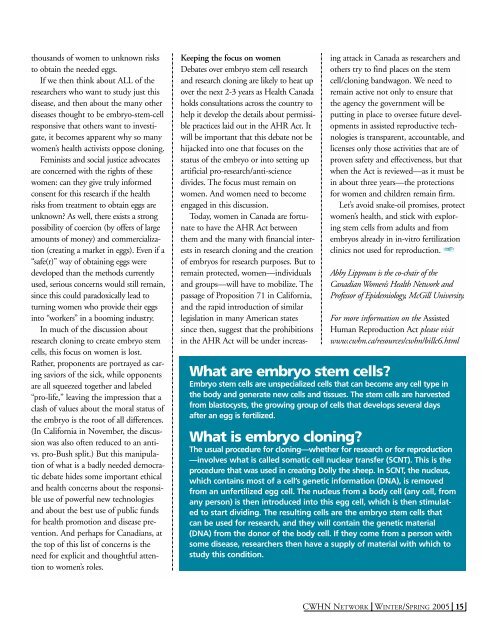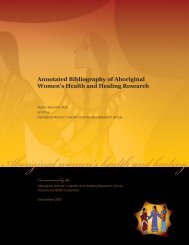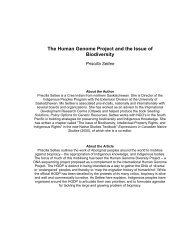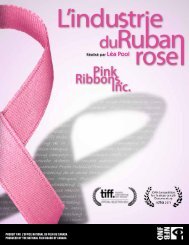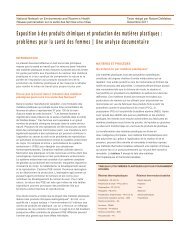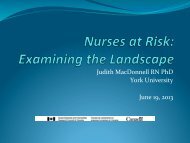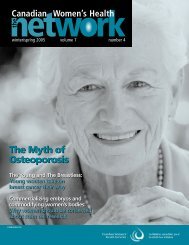NETWORK WIN00 - Canadian Women's Health Network
NETWORK WIN00 - Canadian Women's Health Network
NETWORK WIN00 - Canadian Women's Health Network
Create successful ePaper yourself
Turn your PDF publications into a flip-book with our unique Google optimized e-Paper software.
thousands of women to unknown risks<br />
to obtain the needed eggs.<br />
If we then think about ALL of the<br />
researchers who want to study just this<br />
disease, and then about the many other<br />
diseases thought to be embryo-stem-cell<br />
responsive that others want to investigate,<br />
it becomes apparent why so many<br />
women’s health activists oppose cloning.<br />
Feminists and social justice advocates<br />
are concerned with the rights of these<br />
women: can they give truly informed<br />
consent for this research if the health<br />
risks from treatment to obtain eggs are<br />
unknown? As well, there exists a strong<br />
possibility of coercion (by offers of large<br />
amounts of money) and commercialization<br />
(creating a market in eggs). Even if a<br />
“safe(r)” way of obtaining eggs were<br />
developed than the methods currently<br />
used, serious concerns would still remain,<br />
since this could paradoxically lead to<br />
turning women who provide their eggs<br />
into “workers” in a booming industry.<br />
In much of the discussion about<br />
research cloning to create embryo stem<br />
cells, this focus on women is lost.<br />
Rather, proponents are portrayed as caring<br />
saviors of the sick, while opponents<br />
are all squeezed together and labeled<br />
“pro-life,” leaving the impression that a<br />
clash of values about the moral status of<br />
the embryo is the root of all differences.<br />
(In California in November, the discussion<br />
was also often reduced to an antivs.<br />
pro-Bush split.) But this manipulation<br />
of what is a badly needed democratic<br />
debate hides some important ethical<br />
and health concerns about the responsible<br />
use of powerful new technologies<br />
and about the best use of public funds<br />
for health promotion and disease prevention.<br />
And perhaps for <strong>Canadian</strong>s, at<br />
the top of this list of concerns is the<br />
need for explicit and thoughtful attention<br />
to women’s roles.<br />
Keeping the focus on women<br />
Debates over embryo stem cell research<br />
and research cloning are likely to heat up<br />
over the next 2-3 years as <strong>Health</strong> Canada<br />
holds consultations across the country to<br />
help it develop the details about permissible<br />
practices laid out in the AHR Act. It<br />
will be important that this debate not be<br />
hijacked into one that focuses on the<br />
status of the embryo or into setting up<br />
artificial pro-research/anti-science<br />
divides. The focus must remain on<br />
women. And women need to become<br />
engaged in this discussion.<br />
Today, women in Canada are fortunate<br />
to have the AHR Act between<br />
them and the many with financial interests<br />
in research cloning and the creation<br />
of embryos for research purposes. But to<br />
remain protected, women—individuals<br />
and groups—will have to mobilize. The<br />
passage of Proposition 71 in California,<br />
and the rapid introduction of similar<br />
legislation in many American states<br />
since then, suggest that the prohibitions<br />
in the AHR Act will be under increasing<br />
attack in Canada as researchers and<br />
others try to find places on the stem<br />
cell/cloning bandwagon. We need to<br />
remain active not only to ensure that<br />
the agency the government will be<br />
putting in place to oversee future developments<br />
in assisted reproductive technologies<br />
is transparent, accountable, and<br />
licenses only those activities that are of<br />
proven safety and effectiveness, but that<br />
when the Act is reviewed—as it must be<br />
in about three years—the protections<br />
for women and children remain firm.<br />
Let’s avoid snake-oil promises, protect<br />
women’s health, and stick with exploring<br />
stem cells from adults and from<br />
embryos already in in-vitro fertilization<br />
clinics not used for reproduction. <br />
Abby Lippman is the co-chair of the<br />
<strong>Canadian</strong> Women’s <strong>Health</strong> <strong>Network</strong> and<br />
Professor of Epidemiology, McGill University.<br />
For more information on the Assisted<br />
Human Reproduction Act please visit<br />
www.cwhn.ca/resources/cwhn/billc6.html<br />
What are embryo stem cells?<br />
Embryo stem cells are unspecialized cells that can become any cell type in<br />
the body and generate new cells and tissues. The stem cells are harvested<br />
from blastocysts, the growing group of cells that develops several days<br />
after an egg is fertilized.<br />
What is embryo cloning?<br />
The usual procedure for cloning—whether for research or for reproduction<br />
—involves what is called somatic cell nuclear transfer (SCNT). This is the<br />
procedure that was used in creating Dolly the sheep. In SCNT, the nucleus,<br />
which contains most of a cell’s genetic information (DNA), is removed<br />
from an unfertilized egg cell. The nucleus from a body cell (any cell, from<br />
any person) is then introduced into this egg cell, which is then stimulated<br />
to start dividing. The resulting cells are the embryo stem cells that<br />
can be used for research, and they will contain the genetic material<br />
(DNA) from the donor of the body cell. If they come from a person with<br />
some disease, researchers then have a supply of material with which to<br />
study this condition.<br />
CWHN <strong>NETWORK</strong> WINTER/SPRING 2005 15


